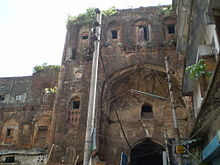Economy of the Mughal Empire
The Mughal Empire's economic prowess and sophisticated infrastructure played a pivotal role in shaping South Asia's history.
[3] Mughal India's economy has been described as a form of proto-industrialization, an inspiration for the 18th-century putting-out system of Western Europe prior to the Industrial Revolution.
[3] India under Mughal rule produced about 28% of the world's industrial output up until the 18th century with significant exports in textiles, shipbuilding, and steel, driving a strong export-driven economy.
[5][6] At the start of 17th century, the economic expansion within Mughal territories become the largest and surpassed the Qing dynasty and Europe.
[6] The Mughals standardized the currency system introduced by Sher Shah Suri, maintaining high purity in their coins and largely relying on imported bullion due to strong exports, particularly from Bengal.
[15] The Mughals adopted and standardised the rupee (rupiya, or silver), Mohur (gold) and dam (copper) currencies introduced by Sur Emperor Sher Shah Suri during his brief rule.
[18] Despite India having its own stocks of gold and silver, the Mughals produced minimal gold of their own, but mostly minted coins from imported bullion, as a result of the empire's strong export-driven economy, with global demand for Indian agricultural and industrial products drawing a steady stream of precious metals into India.
Parthasarathi cites his estimates that grain wages for weaving and spinning in mid-18 century Bengal and South India was comparable to Britain.
[36] Indian peasants were also quick to adapt to profitable new crops, such as maize and tobacco from the New World being rapidly adopted and widely cultivated across Mughal India between 1600 and 1650.
Bengali farmers rapidly learned techniques of mulberry cultivation and sericulture, establishing Bengal Subah as a major silk-producing region of the world.
Evidence for the use of a draw bar for sugar-milling appears at Delhi in 1540, but may also date back earlier, and was mainly used in the northern Indian subcontinent.
[37] The Mughal era sugar production also appeared by the foundings of archaeology evidence by Aligarh Muslim University in 2020 in Agra.
Compared to Britain, the price of grain was about one-half in South India and one-third in Bengal, in terms of silver coinage.
He established a network of diamond merchants in Europe, Africa, the Middle East, and Asia up to China and the Malay Archipelago.
[47][48][49] which Mir Jumla had his own ships and organised merchant fleets in the 1640s that sailed throughout Surat, Thatta, Arakan, Ayuthya, Balasore, Aceh, Melaka, Johore, Bantam, Makassar, Ceylon, Bandar Abbas, Mecca, Jeddah, Basra, Aden, Masqat, Mocha and the Maldives.
[4] In early modern Europe, there was significant demand for products from Mughal India, particularly cotton textiles, as well as goods such as spices, peppers, indigo, silks, and saltpeter (for use in munitions).
The trade imbalance caused Europeans to export large quantities of gold and silver to Mughal India in order to pay for South Asian imports.
[59] Another innovation, the incorporation of the crank handle in the cotton gin, first appeared in India sometime during the late Delhi Sultanate or the early Mughal Empire.
Birbal said, “Your Majesty, from the cotton boll comes the fine fabric prized by merchants across the seas that has made your empire famous throughout the world.
[64] The province of Bengal was especially prosperous from the time of its takeover by the Mughals in 1590 until the British East India Company seized control in 1757.
[10] Akbar played a key role in establishing Bengal as a leading centre of commerce, as he began transforming many of the jungles there into farms.
[68] The calendar played a vital role in developing and organising harvests, tax collection and Bengali culture in general, including the New Year and Autumn festivals.
[69][page needed] Its handloom industry flourished under royal warrants, making the region a hub of the worldwide muslin trade, which peaked in the 17th and 18th centuries.
The Mughals expanded cultivated land in the Bengal delta under the leadership of Sufis, which consolidated the foundation of Bengali Muslim society.
The Nawabs permitted European companies to set up trading posts across the region, including firms from Britain, France, the Netherlands, Denmark, Portugal and Austria.





